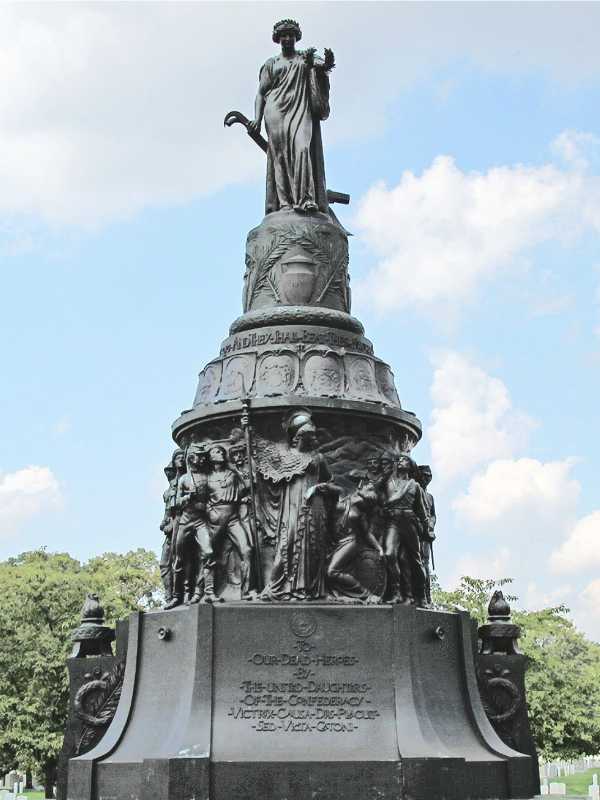



Why would the beautiful reconciliation monument be torn down? They promised monuments in cemeteries would remain untouched, but their agenda means everything.
What is the only reason to take down a historical reconciliation statue?
The US Army is removing it after a so-called bipartisan committee made the decision, and they are ignoring all laws meant to protect it. It’s divisive.
Taking down statues takes down history and doesn’t change a thing about slavery. Someone has to explain why no one cares about the sex trafficking and the slavery we are bringing into this country from over the border. We are allowing child sex traffickers into this country. That’s the slavery that should consume us.
The X poster asked what could possibly be wrong with a Reconciliation monument. The answers are hateful, attacking the dead.
The poster, Blue and Butternut, indicated s/he had the answer – hate. Hate is tearing it down.
This is history. These same people who tear these down want our Founding Fathers gone, too, replaced by statues of some ridiculous people.
The Washington Post complained that dozens of GOP tried to save it. WaPo said, “The commission found about 1,100 assets that commemorate the Confederacy, including base names and street signs, and advised the Pentagon on what should be removed or changed.” This was the last.
Gov. Youngkin is disappointed and said the Army is overstepping. It’s costing $3 million to take it down and leave nothing but a base in its place. Gov. Youngkin will have it erected in New Market Battlefield State Park, 100 miles away.
The Black Lives Matter demonstrations that erupted nationwide after Floyd’s killing by a white police officer, coupled with ongoing efforts to remove Confederate monuments, turned the spotlight on the Army installations. The naming commission created by Congress visited the bases and met with members of the surrounding communities for input.
That is why it’s being removed. Black Lives Matter, a violent communist organization, wants them down.
So much for reconciliation.
ARLINGTON CEMETARY OFFERS A DESCRIPTION OF THE MONUMENT
“The history of the Confederate Memorial embodies the complex and contested legacy of the Civil War at Arlington National Cemetery and in American culture generally.
“In 1900, Congress authorized Confederate remains to be reinterred at Arlington National Cemetery, which designated a special section for them (in what is now Section 16). The Confederate Memorial was erected there in 1914. By the early 1900s, it had become tradition to establish a new section at Arlington for the dead from a particular war, followed by a commemorative monument. “
Reconciliation ended in 1977, leaving the former slaves subject to continued brutality.
“On December 14, 1898 — four days after the Spanish-American War ended — President William McKinley kicked off his “Peace Jubilee” nationwide tour with a speech in Atlanta in which he proclaimed, “in the spirit of fraternity we should share with you in the care of the graves of Confederate soldiers…. Sectional feeling no longer holds back the love we feel for each other. The old flag again waves over us in peace with new glories.” …”
Arlington remained segregated until 1948, when President Harry S. Truman desegregated the armed forces by executive order.
Confederate graves were added to the cemetery.
“On June 7, 1903, the first Confederate Memorial Day ceremonies were held in Arlington’s Confederate section. President Theodore Roosevelt sent a floral arrangement, beginning a tradition continued by nearly every U.S. president. In 2009, President Barack Obama modified the tradition, sending two wreaths: one to the Confederate Memorial, the other to Washington, D.C.’s African American Civil War Memorial, in honor of U.S. Colored Troops.
“In 1906, with Secretary of War William Howard Taft’s approval, the United Daughters of the Confederacy (a hereditary organization of Southern women) began raising funds to erect a memorial in the Confederate section. Through such voluntary civic organizations, women led many late nineteenth- and early twentieth-century efforts to commemorate wars and to mourn the dead — and, in so doing, women gained influence in public life even before they won the right to vote. (In another example of women’s commemorative efforts, the National Society of the Colonial Dames of America was responsible for creating the Spanish-American War Memorial.)
THIS IS THE REASON THEY CLAIM IT MUST GO EVEN THOUGH IT MARKS THE GRAVES OF THE SCULPTOR AND THREE CONFEDERATE SOLDIERS
“Unveiled in 1914, the Confederate Memorial was designed by noted American sculptor Moses Jacob Ezekiel, a Confederate veteran and the first Jewish graduate of Virginia Military Institute. The elaborately designed monument offers a nostalgic, [allegedly] mythologized vision of the Confederacy, including highly sanitized depictions of slavery. Standing on a 32-foot-tall pedestal, a bronze, classical female figure, crowned with olive leaves, represents the American South. She holds a laurel wreath, a plow stock, and a pruning hook, with a Biblical inscription at her feet: “They have beat their swords into plough-shares and their spears into pruning hooks.” The statue stands on a pedestal with four cinerary urns, one for each year of the war, and is supported by a frieze with 14 shields, one for each of the 11 Confederate states and the border states of Maryland, Kentucky and Missouri. Thirty-two life-sized figures depict mythical gods alongside Southern soldiers and civilians.
“Two of these figures are portrayed as African American: an enslaved woman depicted as a “Mammy,” holding the infant child of a white officer, and an enslaved man following his owner to war. An inscription of the Latin phrase “Victrix causa diis placuit sed victa Caton” (“The victorious cause was pleasing to the gods, but the lost cause to Cato”) construes the South’s secession as a noble “Lost Cause.” This narrative of the Lost Cause, which romanticized the pre-Civil War South and denied the horrors of slavery, fueled white backlash against Reconstruction and the rights that the 13th, 14th, and 15th Amendments (1865-1870) had granted to African Americans. The image of the faithful slave, embodied in the two figures on the memorial, appeared widely in American popular culture during the 1910s through 1930s, perhaps most famously in the 1939 film “Gone with the Wind.”
Sculptor Moses Ezekiel was buried at the base of his creation in 1921, after being honored at the first funeral ceremony in the newly built Memorial Amphitheater.
“Three other Confederate soldiers lie next to him: Lt. Harry C. Marmaduke of the Confederate Navy, Capt. John M. Hickey of the Second Missouri Infantry and Brig. Gen. Marcus J. Wright, who commanded brigades at the battles of Shiloh and Chickamauga.
“The Confederate Memorial offers an opportunity for visitors to reflect on the history and meanings of the Civil War, slavery, and the relationship between military service, citizenship and race in America. This memorial, along with the segregated United States Colored Troops graves in Section 27, invites us to understand how politics and culture have historically shaped how Americans have buried and commemorated the dead. Memorialization at a national cemetery became an important marker of citizenship — which, in the post-Reconstruction era, was granted to white Civil War veterans, Confederate or Union, but not to African American soldiers who had served their country. In such ways, the history of Arlington National Cemetery allows us to better understand the complex history of the United States.”
